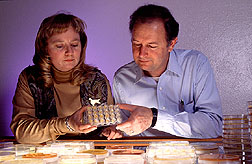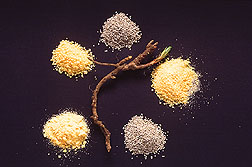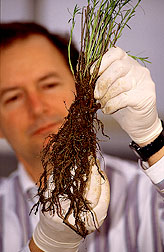Rhizobacteria Underground Biocontrol Allies?
|
|
Roots, as they grow through the soil, ooze organic substances in their wake. If they're scratched, roots exude even more of these substances, thus providing a veritable feast for the plant's microbial friends and foes.
Among a crop plant's friendliest microbes are those that attack weeds. Agricultural Research Service microbiologist Robert J. Kremer at Columbia, Missouri, is rooting for the underground weed foes called deleterious rhizobacteria (DRB.)
In general, rhizobacteria live on plant roots or reside in the rhizosphere, a soil zone spanning a few millimeters around roots, where they feed on plant juices. Deleterious rhizobacteria, which poison plants, don't invade roots as parasites but may enter through wounds.
Once weakened by DRB, weeds are less able to compete with other plants for soil nutrients, moisture, and sunlight. The weakened weeds also become more vulnerable to other control measures.
DRB-produced toxins trigger plant cells to produce excessive hormones that keep seeds from germinating, or they damage the plants by putting life processes in overdrive, Kremer says.
Damage might show up as slow plant growth. Under a microscope, cell fluids may appear discolored. Pressure from a fluid buildup may cause cell walls to break and leak, replenishing the DRB diet.
Now Kremer says DRB may become the basis for a commercial bioherbicide against one of the worst weeds in the West: leafy spurge, Euphorbia esula. A Eurasian native, the weed now infests at least 29 states and costs 4 of them--Montana, Wyoming, and North and South Dakota--an estimated $144 million annually.
Unpalatable to cattle and horses, the weed, if left unattended, overruns untilled land, degrading it even for wildlife habitat. On land suited only for livestock grazing, controlling the weed with chemical herbicides alone may be temporary at best and too expensive--to say nothing of being possibly harmful to other plants.
Although Kremer is no friend of leafy spurge, he's interested in it "mainly as a model plant for tissue-culture-based research on rhizobacteria," he says. Kremer and his colleagues have developed a time- and labor-saving procedure, using leafy spurge tissue culture, to identify which bacteria to test on whole plants for their power to wage biological weed warfare. It may just be the first weed cell culture used to evaluate the potential of DRB.
Rhizobacteria that first piqued researchers' interest increased crop growth either directly, by stimulating hormones, or indirectly, by producing antibiotics that inhibited plant disease microbes. But in the early 1980s, scientists discovered DRB that reduced seed germination and seedling growth of sugar beets, wheat, and citrus.
That's about the time Kremer started looking for microbes that might combat velvetleaf, cocklebur, jimsonweed, and other weeds in cultivated crops of the Midwest and South. His quest also led him to DRB on leafy spurge.
|
|
In the soil around velvetleaf seedling roots, Kremer found the most prevalent microbes included pathogenic, or disease-causing, fungi in the genera Fusarium and Alternaria. He dipped seeds in a liquid suspension of the microbes and planted them for greenhouse tests.
"When the velvetleaf seedlings were 2 weeks old," he says, "we found top growth reduced as much as 88 percent, compared with uninfected plants."
Meanwhile, ARS entomologist Neal R. Spencer, then at Stoneville, Mississippi, was researching the insect Niesthrea louisianica, which feeds only on seeds of velvetleaf, prickly sida, and spurred anoda.
The pathogenic fungi hitchhike on the insect. Then, as the insect feeds on not quite mature but viable weed seeds, the fungi infect the weakened remains. In field tests, Kremer and Spencer found only about 5 percent of velvetleaf seeds survived and germinated after the insect-fungi duo attacked.
Overcoming Impediments
Before bioherbicides for velvetleaf, leafy spurge, or any other weed will merit commercial interest and farmers' acceptance, Kremer says, research must address a number of issues. For example, low-cost methods must be developed to produce effective microbial strains that remain viable in storage and consistently work well under field conditions.
ARS, with its long-term perspectives and wide-ranging expertise, is developing a knowledge base that will be needed to foster biological control technology.
Teamwork by Kremer and Spencer begun in the 1980s recurred in the '90s when Spencer, now at Sidney, Montana, began research on flea beetles that lay their eggs at the base of leafy spurge plants. [See "Leafy Spurge Is Reunited with an Old Enemy," Agricultural Research, April 1994, pp. 20-22.]
ARS plant pathologist Anthony J. Caesar, also at Sidney, discovered that larvae feeding on roots spread not only DRB, but also pathogenic fungi throughout leafy spurge's vast root systems. Caesar and Spencer are evaluating the effectiveness of the insect/fungi interactions in a 5-year areawide integrated pest management (IPM) research project.
To identify which DRB might best control leafy spurge, Kremer first applied strains to seedling roots in growth chamber and greenhouse tests. Strains that worked best could then be field tested. Later, as an alternative to growing seedlings, he grew leafy spurge cells suspended in a liquid culture medium. He then inoculated samples of the liquid suspensions with test bacteria, and after 48 hours, he treated the samples with dye.
Only leafy spurge cells killed by the bacteria were stained by the dye. Selecting the most deadly bacteria by measuring color changes with a spectrophotometer took less labor than measuring root lengths and provided more consistent results, but the process was still tedious.
Kremer decided that testing the bacteria on callus tissue might be even more efficient. Callus is a mass of plant cells not quite as fully developed as cells in a whole plant. The technology for tissue culture had already been developed in the mid-1980s by ARS plant physiologist David G. Davis at Fargo, North Dakota. Callus samples were available from ARS chemist Gary D. Manners at Albany, California.
Further underpinning the idea was previous research completed in Kremer's lab by Thouraya Souissi. She had found that the bacteria caused callus cells to grow poorly, become discolored, and even to leak severely.
Souissi and Kremer developed a visual rating system to compare the toxic powers of various DRBs using plates with 24 wells--sort of micro test tubes--containing nutrients for the callus. Into each well they placed half-gram pieces of leafy spurge callus and a drop of DRB. Forty-eight hours later, the researchers recorded observations on each DRB in a database.
|
|
Testing the various rhizobacteria on multiwell tissue-culture plates requires little laboratory space and takes only one-twentieth of the time needed for whole-weed studies.
"We think this is a cost-effective way to speed assessment of superior biological control agents so they can be put to practical use sooner," Kremer says.
Development of "living pesticides" may also be speeded by changing technologies for producing and storing formulations. [See "The Next Bioherbicide?" Agricultural Research, June 1995, p. 20, and "New Process Keeps Biocontrols Alive Longer," Agricultural Research, October 1998, p. 22.]
Kremer says further advances in bioherbicide technology may depend on insights gained through basic research. To take a closer look at some of the most effective DRBs identified in routine screening, he used an electron microscope.
Strains of Pseudomonas fluorescens and Flavobacterium balustinum seemed to paste themselves directly to the plant cells and set up "factories" for producing toxic compounds. The tissue-cultured cells--like infected cells in whole plants--absorbed the compounds and became deformed and stunted.
Some 10 million cells of one strain of P. syringae applied to the standard half gram of tissue culture reduced the weight of fresh callus by 20 percent within 48 hours. And in preliminary field tests, the isolate has shown further promise, reducing leafy spurge root development. So far, the researchers have found a dozen examples of North American rhizobacteria that were highly toxic to the tissue and showed promise in field tests.
Yet to be screened are about a third of some 2,500 rhizobacteria cultures isolated from weedy Euphorbia species of Europe, as well as North America. Of those rhizobacteria screened already, about 30 percent are highly toxic to leafy spurge. Some of these may prove better suited than others for mass-production and commercial use.
Many DRB feed only on the juices of specific plants. But how do the scientists know whether some DRBs are not going to harm economically useful plants growing in the area where they might be applied?
"That's always a question we try to answer systematically through our research," says Kremer. Rhizobacteria not native to an area where they might be used merit greater scrutiny than native ones. Before outdoor tests can be done, scientists will conduct extensive indoor studies.--By Ben Hardin, Agricultural Research Service Information Staff.
Robert J. Kremer is in the USDA-ARS Cropping System and Water Quality Research Unit, Room 302, ABNR Bldg., University of Missouri, Columbia, MO 65211; phone (573) 882-6408, fax (573) 884-5070.
Neal R. Spencer and Anthony J. Caesar are at the USDA-ARS Northern Plains Agricultural Research Laboratory, 1500 North Central Ave., Sidney, MT 59270; phone (406) 482-2020, fax (406) 482-5038.
"RHIZOBACTERIA Underground Biocontrol Allies?" was published in the October 1998 issue of Agricultural Research magazine. Click here to see this issue's table of contents.









